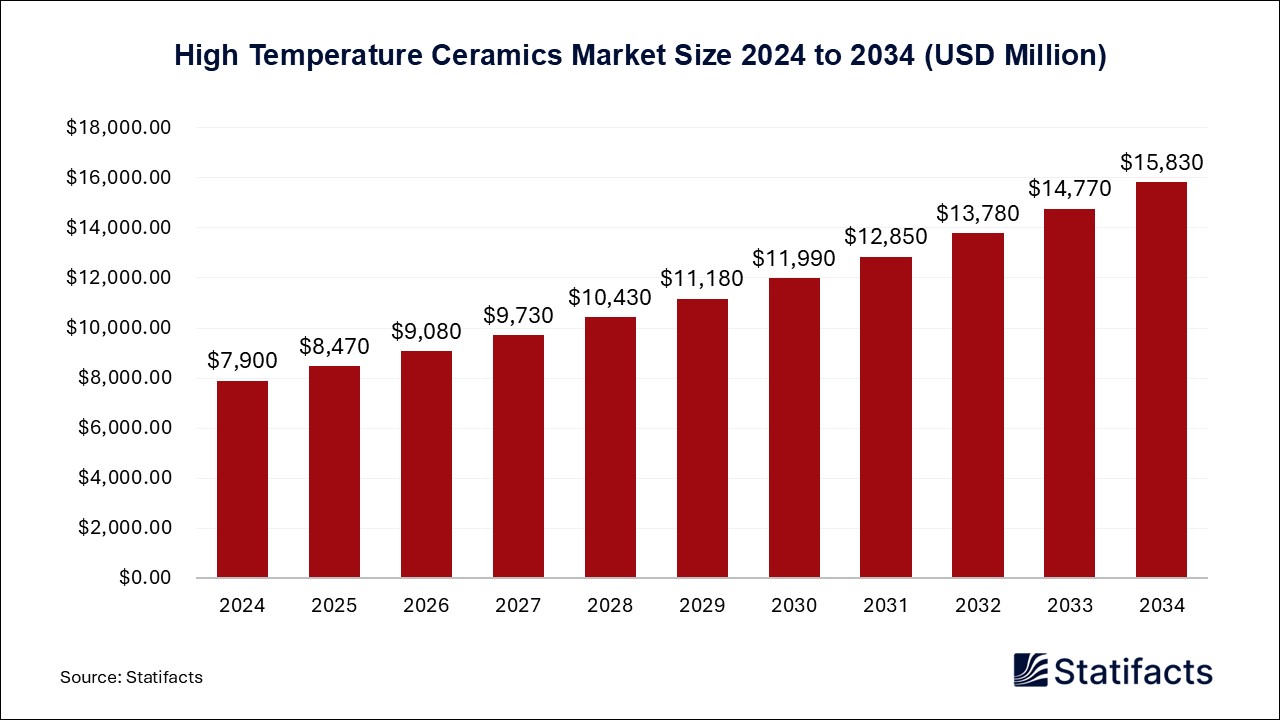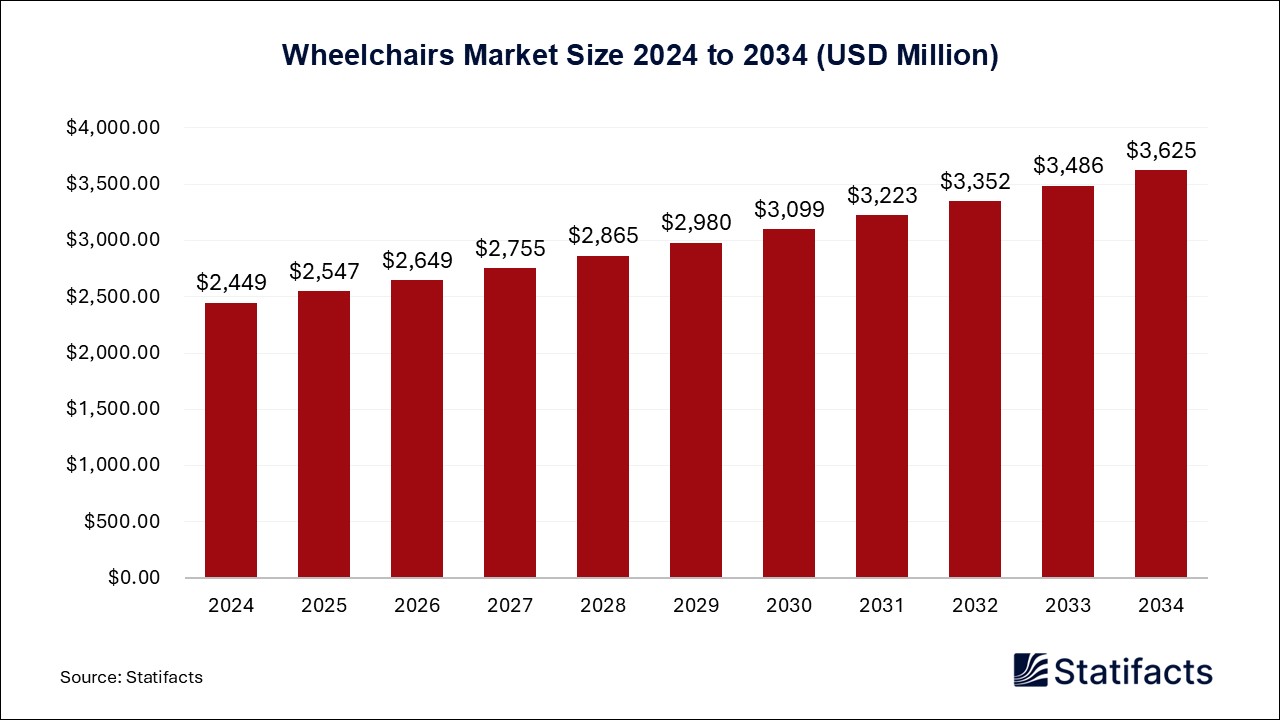Last Updated: 15 Jul 2025
Source: Statifacts
By clicking “Accept All Cookies” you agree to the storing of cookies on your device to enhance site navigation, analyze site usage, and assist in our marketing efforts.
Privacy PolicyThe global cardiology market size was evaluated at USD 37.26 billion in 2024 and is expected to grow around USD 132.02 billion by 2034, registering a CAGR of 13.48% from 2025 to 2034. Cardiology, being a top subject, has seen strong growth, driven by the increasing incidence of cardiovascular diseases, an aging population, and technological advancements. North America dominated the global market, and Asia Pacific is expected to grow at the fastest CAGR during the forecast period.
| Industry Worth | Details |
| Market Size in 2025 | USD 41.93 Billion |
| Market Size by 2034 | USD 132.02 Billion |
| Market Growth Rate from 2025 to 2034 | CAGR of 13.48% |
The cardiology market is considered an essential arm of the healthcare sector, with heart diseases diagnosed and managed under this digital solution. These systems deal with the storage, management, and retrieval of large amounts of data related to cardiology from various fields, from imaging to diagnostics, treatment, and follow-ups. They act as a data collection agency, merging information from several modalities so that the cardiologists and care teams can act on clinical decisions in real time. Rising cases of cardiovascular disease demand more efficient, coordinated, and data-driven modes of care. Improvements in minimally invasive procedures, imaging systems, and remote monitoring are enhancing outcomes and reducing barriers to care. Increases in healthcare spending, combined with heightened awareness of the importance of early diagnosis and treatment of heart ailments, are also intensifying demand. Clinical trials nowadays develop innovative methods to manage coronary artery disease, heart failure, and arrhythmias. All these factors are disrupting cardiology as one of the top fields in healthcare innovation and investment worldwide.
By increasing diagnostic accuracy, tailor-made treatment modalities, effective workflow management, and proactive patient care modalities, artificial intelligence is truly revolutionizing the practice of cardiology. By utilizing large amounts of medical data, AI-based algorithms detected patterns and anomalies faster than traditional ways and, in so doing, precipitated the earlier diagnosis of arrhythmias, heart failure, and coronary artery disease. Similarly, it can predict the risk by spotting individuals in high-risk groups from EHR, genetic data, and lifestyle factors, leading to further personalized treatment plans. Clinical information systems are incorporating AI in a large way and making healthcare practices efficient by providing seamless patient data access, cutting out unnecessary duplication of tests, and improving patient outcomes. Also, advanced processes such as artificial intelligence, machine learning, and natural language processing further augment the capabilities of clinical information systems in terms of evidence-based diagnosis, planning treatment options, and developing risk prediction models.
Artificial intelligence applications also limit the routine tasks for cardiologists so they can concentrate on caring for their patients. Remote patient monitoring provided by AI-powered wearables detects early signs of inpatient complications and reduces hospital admissions.
The major market drivers in the cardiology market are changing consumer choices, a shift towards minimally invasive procedures, and advanced technology.
Shift towards minimally invasive procedures: The growth in the market for cardiology is fueled by the trend favoring minimally invasive procedures and the increasing popularity of interventions such as percutaneous coronary interventions, transcatheter aortic valve replacements, and catheter ablations. There is a significant rise in interventional cardiology, which focuses on treating heart and blood vessel conditions using minimally invasive, catheter-based procedures. These procedures are less invasive, run a low risk of infections, and generally lower level of pain, short hospital stays, and recovery periods. With good technological advancements, such interventions are optimized in precision and safety, and with a superior efficiency level, doctors carry out complex interventions, significantly making a much greater number of patients eligible for advanced treatment, especially those who were previously regarded as high-risk surgical candidates.
Increased public awareness: With increased public awareness and importance given to preventive cardiology, cardiology is a growing market. Health organizations and governments are involved in campaigns that promote early detection and prevention through community screenings and wellness programs. This, thus, tends to promote individuals to recognize risk factors, such as high blood pressure, cholesterol, obesity, and smoking habits. More patients are now asking for diagnostic tests, for instance, electrocardiograms, echocardiography, and coronary CT angiograms, leading to the requirement for diagnostic devices related to cardiology growing. Preventive care actions include lifestyle modifications and pharmaceutical measures to reduce risks before major cardiac incidents occur. Smart developments in wearable technologies and patient monitoring management systems complement this.
The growth of the cardiology market is restrained by factors such as high costs of advanced treatments, stringent regulatory hurdles, and the availability of alternative treatments.
Stringent regulatory hurdles: Cardiovascular technologies are always faced with strict regulations from the FDA and EMA. These regulators define a series of safety, efficacy, and quality standards for the devices and treatments used in the field of cardiology while, at the same time, creating delays in development and additional costs to the manufacturer. The steps for approvals that start from clinical trial phases all the ways to approval-to-commercial protocol documentation is the higher challenge, especially for small companies or startups, due to a lack of financial strength. On the other hand, this hinders innovation and delays the marketing of life-saving technologies. Either quicker approval designs need to be taken, or regulators and manufacturers will have to work more closely for riding innovation, while still attaining the highest standard of safety.
Alternative Treatments: Non-invasive and pharmacological treatment methods like statins, beta-blockers, anticoagulants, and other lipid-lowering agents have been slowly diminishing the need for interventional surgical or device-based procedures. Lifestyle measures have also been finding increased acceptance as inexpensive measures for CVD prevention: changes to diet, exercising more, smoking cessation, and stress reduction. This option is certainly less invasive and more accessible to the common man. The demand for high-cost diagnostic and interventional tools can thereby be affected.
The opportunities in the cardiology market are associated with increasing research and development projects, technological advancement, and government support. There is also a rising awareness of childhood heart conditions, advancements in diagnostic and treatment options, and the rising prevalence of congenital heart defects.
Technological advances are revolutionizing the cardiology market by way of diagnosis, treatment, and long-term management of cardiac diseases. Minimally invasive procedures like bioresorbable stents and robotic-assisted surgical techniques are transforming interventional cardiology, making recovery easier and with fewer complications. Such methods are useful when treating high-risk patients or elderly patients. Advanced ECG techniques with wearables and AI-type monitors are giving cardiac data in real time while also signaling an oncoming heart abnormality. Cardiac marker testing is now more refined to assist in quicker and more precise diagnosis of acute conditions affecting the heart. AI- and IoT-based remote monitoring devices for patient care are fast becoming essential in managing chronic diseases, with clinicians able to monitor vital signs pertaining to chronic conditions and intervene early upon detection of abnormalities. These technological improvements hence help improve patient outcomes as well as efficiency and accessibility, thereby asserting much sustained growth in markets related to cardiology.
“We created Auxira to help teams stay grounded in the clinical work that matters, by embedding trusted support directly into daily workflows and extending their capacity to care. It is a model built with and for physicians to meet today’s demand without compromising on quality or connection.”
“Expanding access to CCTA is crucial for managing the rising prevalence of CVD, ensuring timely and accurate diagnoses for a larger patient population.”
The Intervention cardiology devices segment dominated the market and is expected to grow at the fastest rate during the forecast period, for the ever-increasing number of cardiovascular diseases globally, technological advancements, and an aging population with a preference for less invasive treatment. These instruments allow for small access interventions like angioplasty, stent placement, and atherectomy that offer rapid recovery, fewer complications, and shorter hospital stays. Currently, drug-eluting stents form the choice of treatment for coronary artery disease alongside imaging modalities like Optical Coherence Tomography and Intravascular Ultrasound for better diagnosis and precise therapy. In the wake of promoting value-based care systems, the demand for interventional cardiology devices is expected to rise.
The peripheral vascular devices segment is expected to grow at a considerable rate during the forecast period, as PAD cases are increasing and treatment options vary between invasive and minimally invasive methods. These devices include angioplasty balloons, stents, guidewires, and catheters, and they are used to allow blood flow to arteries that are narrowed or blocked, mostly in the lower extremities. The use of these devices is done with smaller incisions, less pain, less time spent in the hospital, and shorter recovery, with fewer complications as compared to the traditional surgical procedures. Further development from technological advances will help to improve the results, subsequently increasing the role of peripheral vascular devices in interventional cardiology.
North America dominated the global cardiology market on account of its established healthcare infrastructure, high health expenditures, increasing elderly population, and strong adoption of new technologies. There is a high CVD prevalence rate in the US, along with skilled cardiologists and continuous R&D investment. However, with all the increased incidence of CVD, urbanization, sedentary lifestyles, and dietary changes, Asia Pacific is likely to gain the fastest growth. Increased healthcare expenditures, disease detection initiatives undertaken earlier, increasing accessibility of medical insurance, healthcare infrastructure developments, and rapid pace of increase in countries like China, India, and Japan are some of the factors accelerating this market growth. Adoption of advanced interventional cardiology devices and telecardiology solutions is also picking up, owing to the demand for affordable and accessible care. In addition to that, Asia-Pacific is setting itself up to become the most energetic and fastest-growing region in the cardiology market.
The market is moderately fragmented with local players like GE HealthCare Technologies Inc., McKesson Corporation, Honeywell International Inc., etc., wishing to take the time to edge their presence through investments, partnerships, acquisitions, and mergers. They also invest in product development and competitive pricing. These strategies will promote market growth and lucrative opportunities for market players
GE HealthCare Technologies Inc. (GEHC) reported annual revenue of $19.67 billion in 2024, a 0.61% increase compared to $19.55 billion in 2023.
Honeywell International Inc. reported annual revenue of $38.50 billion for the year 2024, a 5.01% increase compared to 2023
For the fiscal year 2025, McKesson reported a total revenue of $359.05 billion, a 16.2% increase compared to the previous year.
Published by Kesiya Chacko
Last Updated: 15 Jul 2025
Source: Statifacts
Last Updated: 15 Jul 2025
Source: Statifacts
| Subsegment | 2024 | 2025 | 2026 | 2027 | 2028 | 2029 | 2030 | 2031 | 2032 | 2033 | 2034 |
|---|---|---|---|---|---|---|---|---|---|---|---|
| Interventional Cardiology Devices | 22,716.21 | 25,691.85 | 29,104.98 | 33,027.12 | 37,543.04 | 42,753.56 | 48,779.05 | 55,763.81 | 63,881.55 | 73,342.30 | 84,401.20 |
| Peripheral Vascular Devices | 14,322.67 | 16,046.82 | 17,997.30 | 20,206.63 | 22,712.64 | 25,559.60 | 28,799.45 | 32,493.46 | 36,714.20 | 41,548.03 | 47,098.32 |
| Others | 3,316.90 | 3,633.34 | 3,983.53 | 4,371.69 | 4,802.73 | 5,282.42 | 5,817.56 | 6,416.17 | 7,087.86 | 7,844.13 | 8,698.86 |
Last Updated: 15 Jul 2025
Source: Statifacts
| Subsegment | 2024 | 2025 | 2026 | 2027 | 2028 | 2029 | 2030 | 2031 | 2032 | 2033 | 2034 |
|---|---|---|---|---|---|---|---|---|---|---|---|
| Interventional Cardiology Devices | 22,716.21 | 25,691.85 | 29,104.98 | 33,027.12 | 37,543.04 | 42,753.56 | 48,779.05 | 55,763.81 | 63,881.55 | 73,342.30 | 84,401.20 |
| Peripheral Vascular Devices | 14,322.67 | 16,046.82 | 17,997.30 | 20,206.63 | 22,712.64 | 25,559.60 | 28,799.45 | 32,493.46 | 36,714.20 | 41,548.03 | 47,098.32 |
| Others | 3,316.90 | 3,633.34 | 3,983.53 | 4,371.69 | 4,802.73 | 5,282.42 | 5,817.56 | 6,416.17 | 7,087.86 | 7,844.13 | 8,698.86 |
The market is driven by the rising prevalence of cardiovascular diseases, an aging global population, sedentary lifestyles, and increased investment in advanced diagnostic and treatment technologies.
Key segments include diagnostic devices (like ECG and echocardiography), interventional cardiology devices (such as stents and catheters), and cardiovascular drugs for hypertension, cholesterol, and heart failure.
Technologies like AI-based diagnostics, wearable cardiac monitors, minimally invasive procedures, and drug-eluting stents are revolutionizing cardiac care and improving patient outcomes.
Telecardiology enables remote monitoring, diagnosis, and consultation for heart conditions, expanding access to care, especially in rural or underserved areas, and reducing hospital visits.
Challenges include high treatment costs, reimbursement limitations, and disparities in access to care, particularly in low- and middle-income regions
To get full access to our Market Insights, you need a Professional Account or a Business Suite.

You will receive an email from our Business Development Manager. Please be sure to check your SPAM/JUNK folder too.

You will receive an email from our Business Development Manager. Please be sure to check your SPAM/JUNK folder too.

Our customers work more efficiently and benefit from



